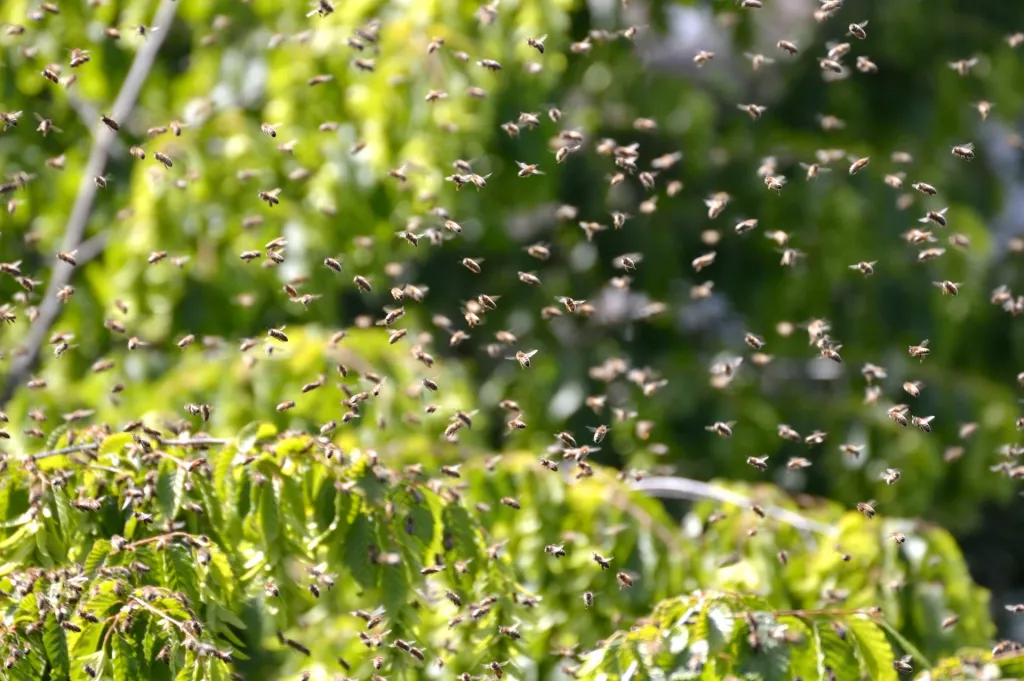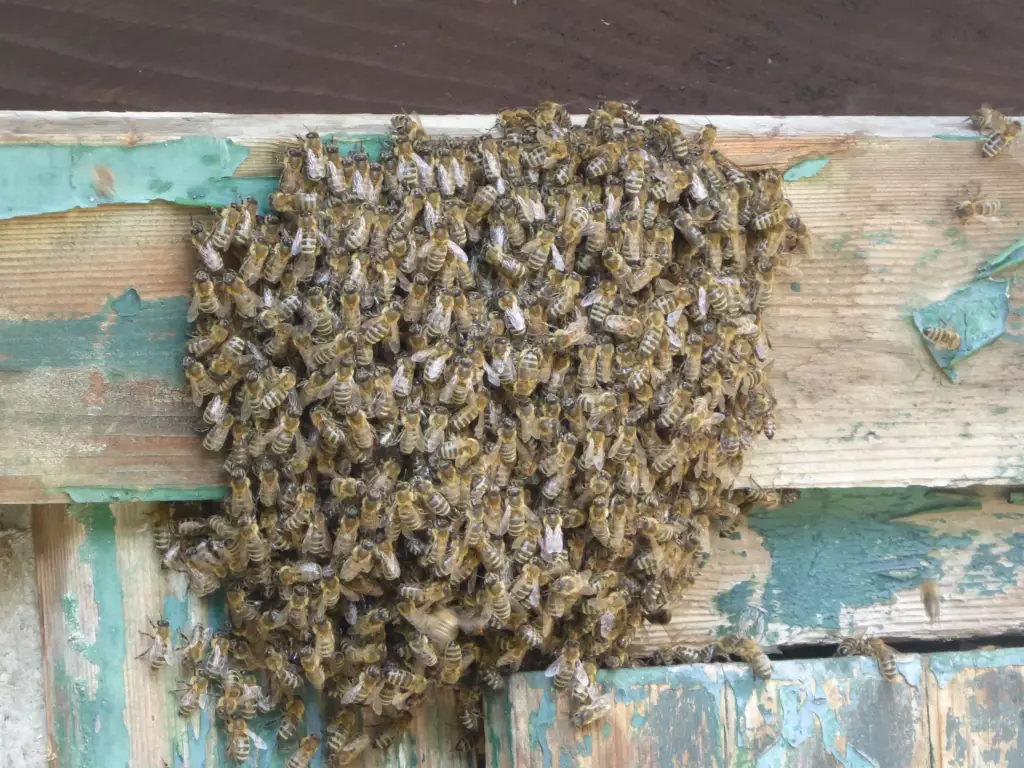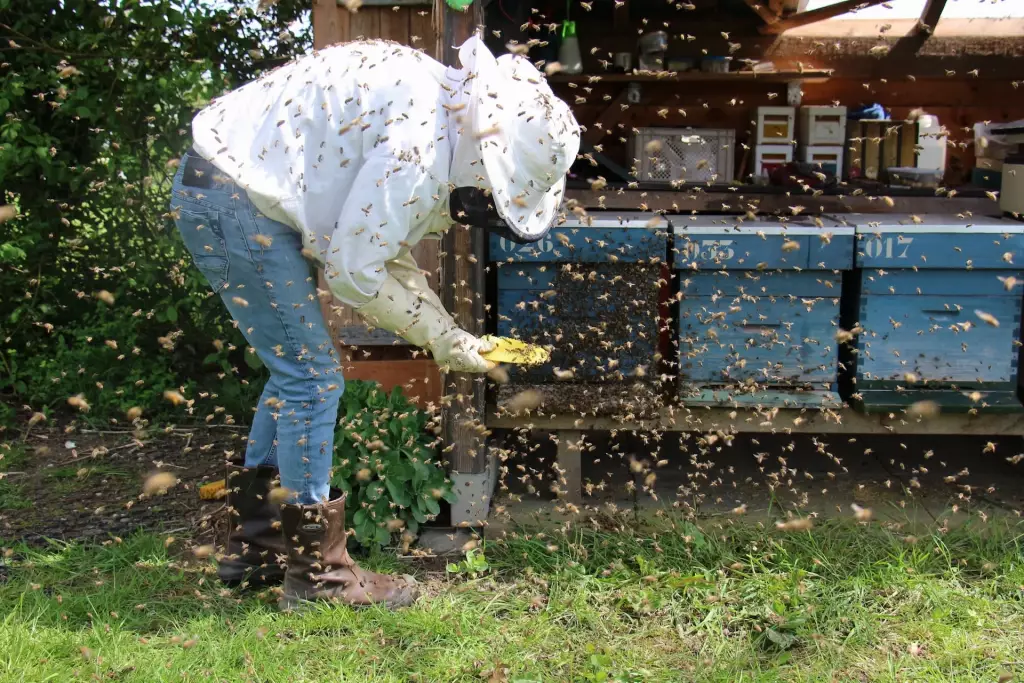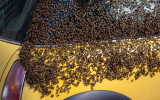What Happens to Bees Left Behind After Swarming or Moving?
It is quite typical to see several bees flying around where a hive or swarm had previously been. When a hive disappears, the bees swarm and leave the hive, but occasionally you'll find a few stray bees.
Bees left behind after swarming will no longer have a queen in the original hive. Bees left behind after moving a hive or swarm become straggler bees. The stray bees still hang around the hive or swarm site, and spend a lot of time flying around looking for their queen.
These bees can live for a few days, but they will probably run out of food and eventually die. Some of them try to join nearby hives, especially foragers who bring pollen and nectar with them.
Summary
- Straggler bees either attempt to join nearby beehives or stay around their old hive and perish within a few days.
- Bees use the sun, magnetic force lines, and visual landmarks to help them find their way back to the hive.
- Swarming interrupts the cycle of egg production and brood rearing.

On this page:
The Bees Left Behind After Swarming
A colony left behind after swarming is frequently left with half of the bees without a queen and a few resources and will produce little honey, and will sometimes become too weak to survive the winter. The worker bees know what to do.
The workers will raise a new queen from the brood left. A virgin queen will be raised, hatch, go on a mating flight, and hopefully come back to begin expanding the colony in the hive that was left behind. The time it takes to rear a new queen can delay brood production by more than a month.
The original hive won't have a queen anymore, but queen eggs and larvae are left on the brood comb. 25–50 percent of the workers and capped queen cells, from which one or more virgin queens will emerge, are still present in the original hive. One of these will succeed the current queen and take over the nest after a mating flight.
Upon inspection, if the tips of the oldest-looking cells are still intact, the hive might not yet have a new queen in place. However, if you find queen cells with side holes in them, there probably is at least one queen wandering around in the hive, eliminating her rivals before they can emerge.
Perhaps there are already several virgin queens among the bees. In that situation, there is a chance that a virgin queen will cause the hive to swarm once more, further reducing its population. A colony may continue to swarm with each new generation of virgin queens until it is too small to sustain itself.
Swarming causes an interruption in the egg-laying and brood-rearing cycle, which disrupts the life cycles of brood illnesses and predators like the Varroa mite.

The bees in the old colony that were left behind will look to the brood cells for their new queen. If more than one cell hatches, more than one queen will compete for control, with the strongest queen emerging victorious. Only one will succeed as the previous colony's queen.
Swarming frequently occurs during a time of year when nectar is abundant because the bees that remain have to survive for a long time without any assistance.
In excellent weather, most swarms depart the colony between 10 AM and 2 PM, fly to a nearby tree or bush, and land on a branch. The bees have a relatively gentle demeanor immediately after landing and over the following 24 to 36 hours. Swarming is their main concern, rather than colony defense.
The swarming bees may occasionally land on a tree or a bush if they are flying toward a particularly high honey flow. The following morning, scout bees emerge from the swarm's cluster to search for suitable nesting sites for the colony to settle.
There are times they find a favorable location so quickly that they leave before all the scouts have returned. Then, once a swarm departs, you will discover bees that were left behind. They frequently return to their original beehive and the bees sort of disappear after a day or two. Other times, they simply go and join other hives.
The Bees Left Behind After Moving A Hive
In this instance, the worker bees left behind after a hive removal are those that are out in the field gathering nectar. They will eventually discover that their house has been moved. These poor abandoned worker bees would gather together for one or two days before departing to join other hives or dying on their own.
Try not to move beehives during the daytime because you run the danger of leaving the foraging bees behind. The straggler bees included bees that took flight during this procedure as well as bees coming home from scouting, foraging, or orientation flights.
Beekeepers advise relocating hives at night, after all the bees have gone back to the hive. By doing this, the majority, if not all of the bees that belong in the hive stay there. The foragers who are out looking for flowers will return to find their hive has vanished if you try to transfer a hive during the day.
You may also simply leave one empty box in the middle of the apiary site or your bee farm and return the next day in the evening. You'll be able to gather a few pounds of bees, sugar them, and then put them into a weak hive. They should not be ignored because they contain pollen and nectar.
How Do Bees Return To The Same Hive?
When returning to their hive, bees often use the sun and magnetic force lines in the earth to guide them. In the final few feet, they then employ visual cues to locate their colony. When bees orientate, they exit the hive and turn to face the entrance, as if to say, "Yes, this is how my house looks."
Bees use landmarks to help them find their way back to the hive when they are out foraging. They gauge their speed in relation to the passing scenery using polarized light. In order to locate themselves using magnetic shifts in their environment, bees additionally have an internal navigation mechanism that functions like a GPS.
Having learned how to get back home once, they don't need to reorient themselves every time they leave the hive—at least, not until you move the hive, and this is when the issue arises.
Foragers who are out will have a hard time finding their hive if you move it more than a few paces. A returning forager in an apiary, where numerous hives are close together, would probably join a nearby hive.

There is an old saying in beekeeping that you only move the hive three feet or three miles. When hives are close to one another, it is not unusual for bees to actually go to the wrong one, especially if they are all facing in the same direction and are the same color. While this is generally accurate, there are several ways beekeepers persuade bees to reorient without being in a distant area.
The notion is that when a bee leaves her hive and the land markers are not the same, she will reorient. When you have just one hive, and you move it even 10 or 15 feet while the foragers are out, the majority of them will ultimately find their way back by flying aimlessly in large circles.
